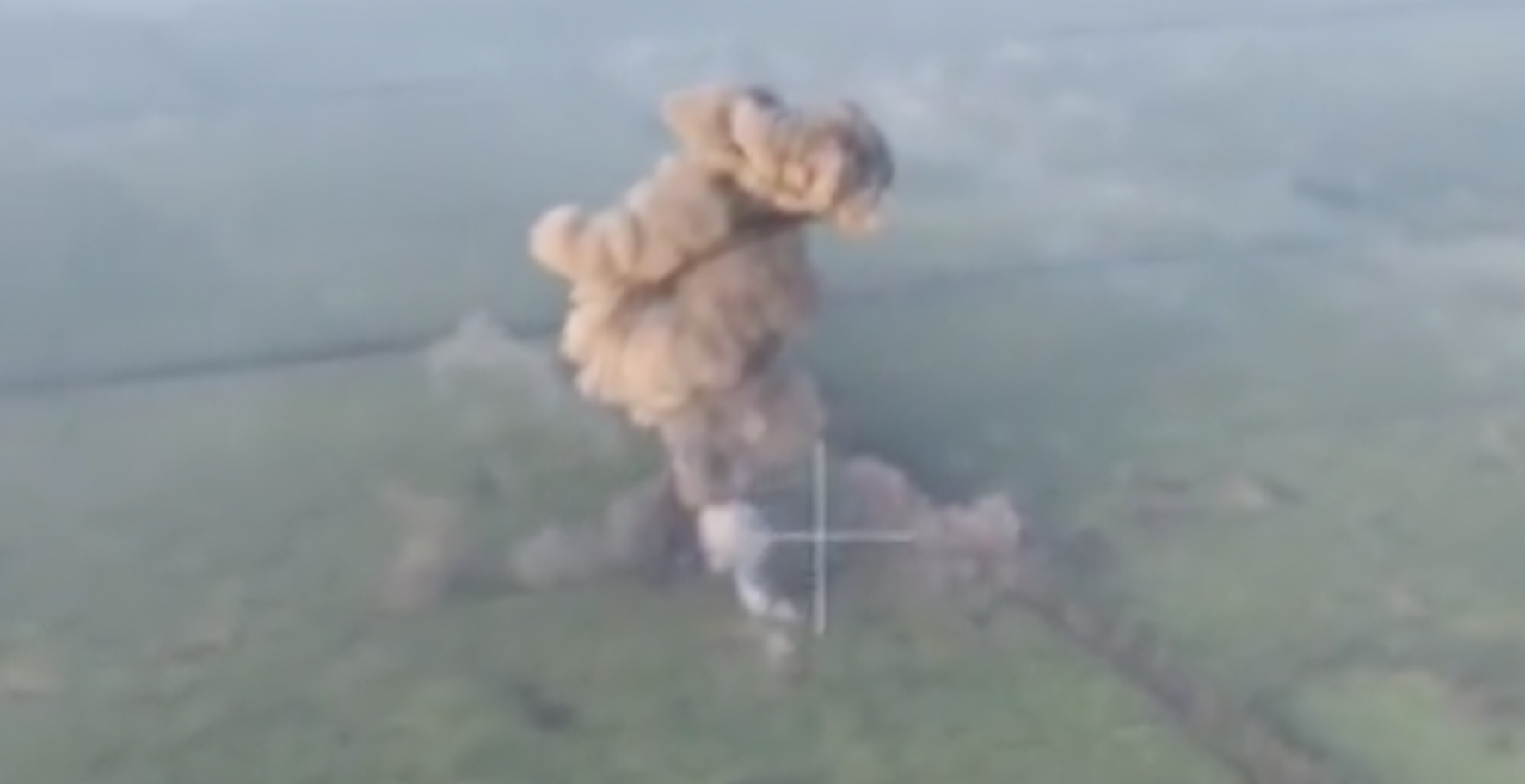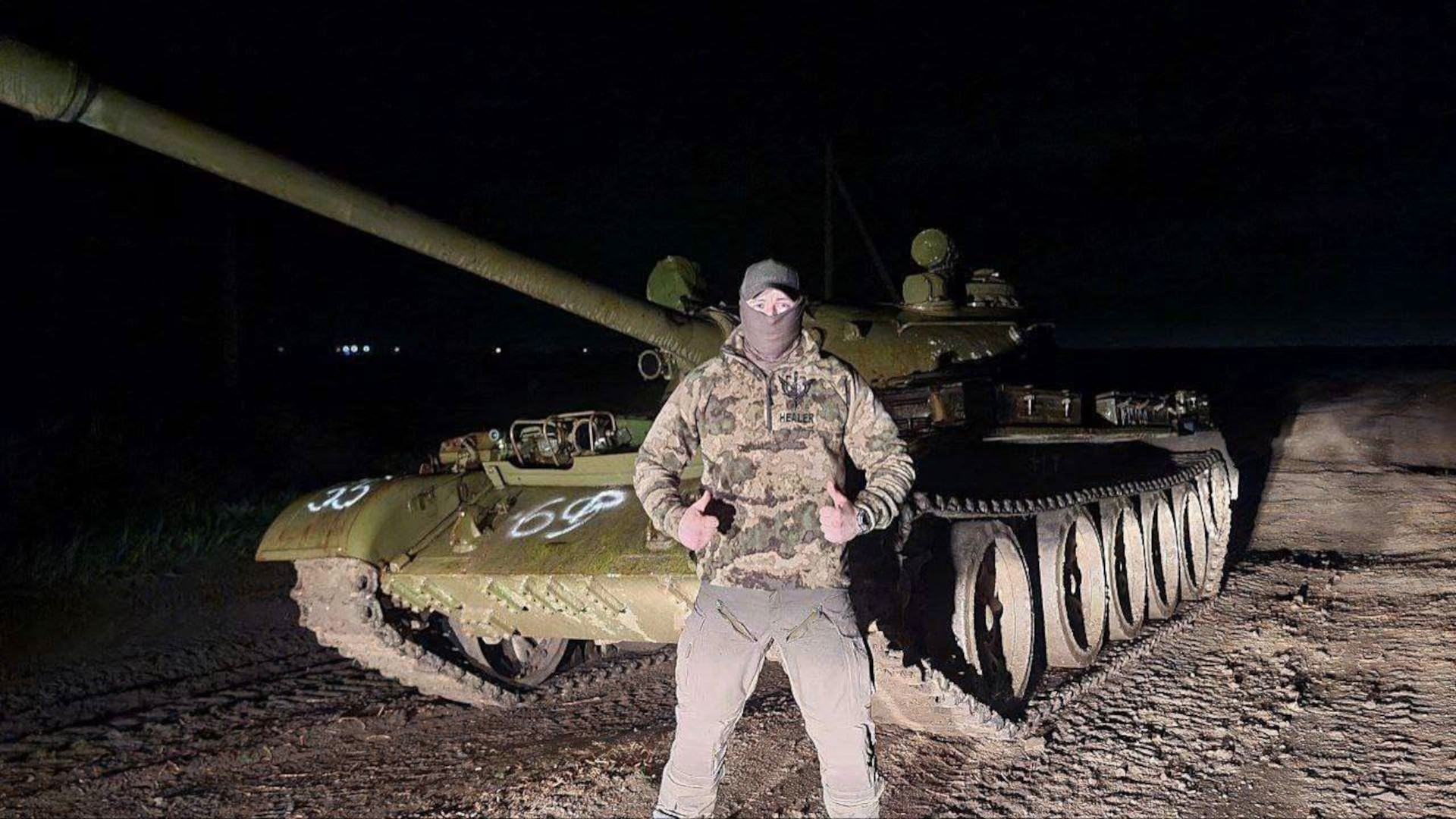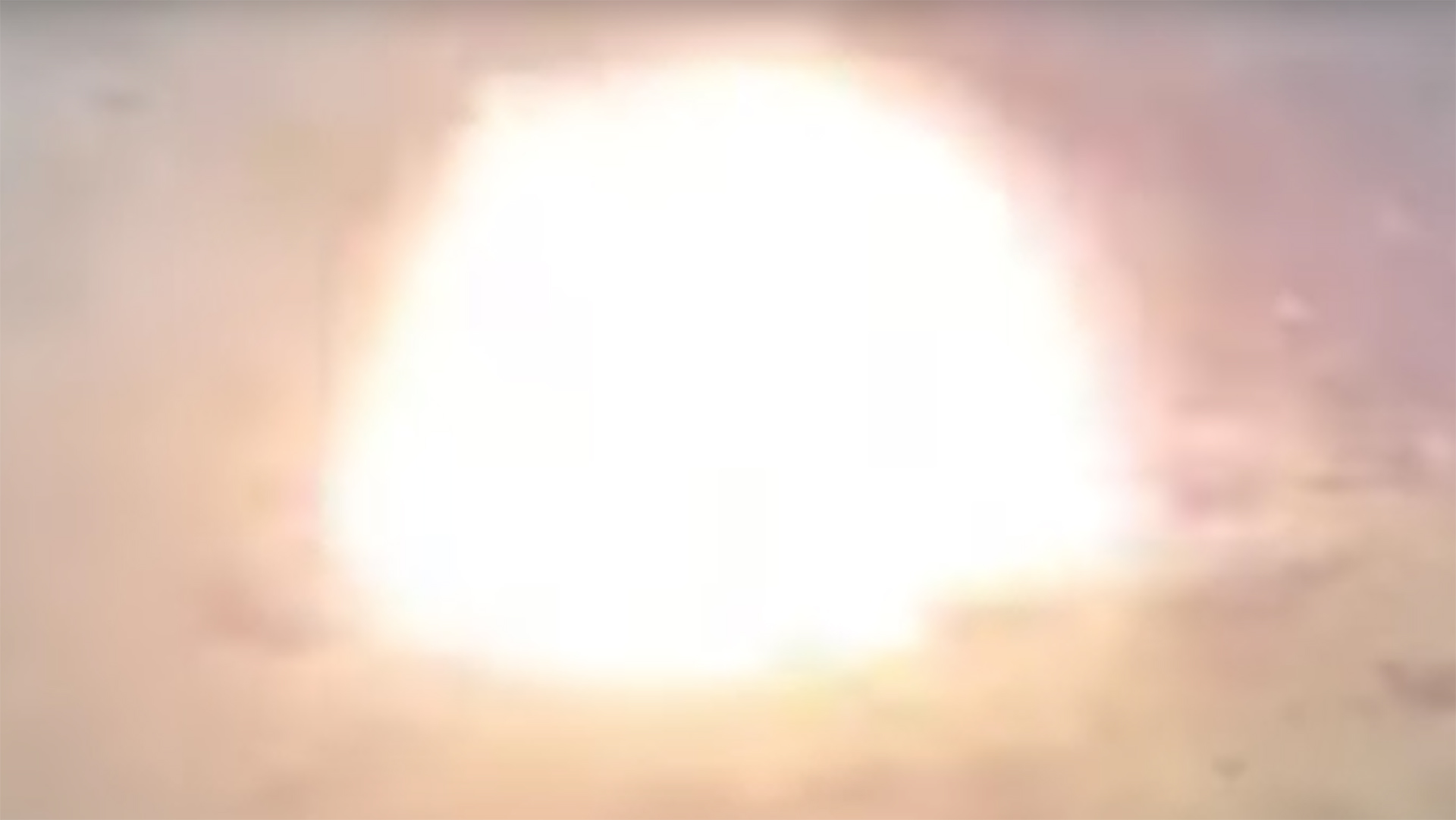Russia appears to now be packing nearly antique T-54/55 tanks with explosives and pointing them at Ukrainian positions on the battlefield, before detonating them under remote control in an attempt to blast their way through. A recent video seems to provide the first confirmation of a T-54/55 tank being rigged for this purpose, as a vehicle-borne improvised explosive device (VBIED), although exactly how effective this effort was is open to debate.

In a post on its Telegram channel over the weekend, the Russian Ministry of Defense claimed that an uncrewed tank was used successfully to destroy a Ukrainian stronghold. The ministry stated that the tank had been filled with “about 3.5 tons of TNT and five FAB-100 bombs” that were detonated by remote control. The FAB-100 is an air-dropped bomb weighing around 220 pounds.
The same Telegram post included quotes from a Russian tank commander, with the callsign “Bernaul,” who, it is said, was responsible for executing the attack.
“About 300 meters [980 feet] away from the enemy, the tank operator put the vehicle on manual gas, directing it [to the enemy’s] direction. He jumped out and went to the rear. I stayed behind to observe, and after the vehicle approached the enemy’s positions, I detonated it by radio control,” Bernaul said.
“The explosion was very serious, there were a lot of explosives … as a result, according to radio intercept data, the enemy suffered significant losses,” the commander added.
The accompanying video, taken from a drone, shows the tank — either a T-54 or a T-55 — rolling over ground pockmarked with shell holes, presumably toward the Ukrainian position. Before reaching Ukrainian lines, the tank is then brought to a standstill by an explosion. Multiple reports — including from pro-Russian bloggers — have stated this was likely caused by a mine.
The tank finally explodes in an enormous fireball, leaving a pall of smoke towering over the battlefield. Only moments before that detonation, there is a distinctive flash emanating from the Ukrainian positions ahead of the tank — there have been some suggestions this was an anti-tank missile or a rocket-propelled grenade, but we can’t say for sure. Regardless, it was clearly an attempt to knock out the VBIED, but whether that shot led to the huge explosion, or if that had actually been triggered by the earlier mine or detonated via remote control, isn’t known definitively. Still, based on the timing and what is shown in the video, it was likely a killshot from the Ukrainians that caused the tank to detonate.

One prominent Russian military blogger, going by the name Voennyi Osvedomitel, provided the following account of the incident: “Sending an unmanned kamikaze tank filled with six tons of TNT to Ukrainian positions in Mariinka. Unfortunately, he didn’t make it, blown up by a mine.”

While we cannot confirm that the VBIED was used in the Mariinka area, this part of the Donetsk region, in the southeast of Ukraine, has certainly seen a good deal of intense fighting since the counteroffensive kicked-off, as well as before that.
Based on what the video appears to show, as well as different accounts of the incident, it seems unlikely, however, that the VBIED was anywhere near as successful as the Russian Ministry of Defense originally claimed.
On the other hand, the use of a tank-based VBIED is a noteworthy development in itself.
Using armored vehicles of any kind as VBIEDs offers a much greater degree of survivability compared with even up-armored civilian vehicles, increasing the likelihood that they will successfully reach their target. At the same time, the power reserves and mobility of these kinds of vehicles mean they can potentially carry very large loads of explosives and also traverse challenging terrain.
Pro-Ukrainian elements may well have used a VBIED of a very different kind to prosecute the attack on the Kerch Bridge in October last year, with much evidence pointing to a truck-borne IED being the most likely culprit. It remains unclear, however, if the driver was unaware of the lethal cargo, or if they were actually at the controls of what was a suicide vehicle-borne improvised explosive device (SVBIED), of the kind used widely by ISIS in Iraq and Syria.
On the Russian side, there has been at least one other official report of a VBIED based on an armored fighting vehicle being used recently against Ukrainian forces.
This weekend, the Russian Ministry of Defense claimed that its soldiers had adapted an MT-LB tracked armored fighting vehicle as a VBIED. Packed with FAB-100 bombs and UR-77 mine-clearing charges, the ministry says that the MT-LB was used against a Ukrainian position. A video provided by the ministry does not show the results of the attack, so it’s unclear if this was effective or not.
However, Russian use of VBIEDs could be an emerging new tactic, especially as Ukrainian forces continue to make incremental gains in their counter-offensive.
While any kind of older armored vehicle would potentially make a suitable candidate for adaptation as a VBIED, the fact that the T-54/55 series of tanks are being used in this way is certainly interesting.
In March this year, The War Zone looked at some of the first evidence that examples of the T-54/55 tank — the first prototype of which was completed in 1945 — were headed to Ukraine. At this point, it was unclear if these tanks would actually end up on the front line in Ukraine, although it certainly seemed to point to the increasingly desperate measures taken by Moscow to address its alarming fighting vehicle losses in the conflict.
Video that appeared in March 2023 showing a train carrying T-54/55 series tanks, likely being transported from Arsenyev, in Primorsky Krai, in the Russian Far East, toward the west, and Ukraine:

As we pointed out then, using T-54/55s in their original combat role would leave them “at a huge disadvantage in virtually every way, from armor to sensors.” This would be especially true “if they are expected to face the plethora of modern anti-tank weapons, not to mention advanced Western main battle tanks that are now starting to be delivered to Ukraine.”
Within only around a month, it appeared that Russian forces had started deploying T-54/T-55 series tanks on the battlefield in Ukraine, when one was sighted, reportedly in southeastern Ukraine.
We speculated in the past that the T-54/55 (as well as the only slightly more modern T-62 tank) might still have utility as mobile artillery or protecting rear areas, while even using them as static artillery, in certain scenarios, could be effective.
However, converting T-54/55s into VBIEDs is a trend that might well be adopted more widely.
Not only does Russia have large stocks of these veteran tanks to call upon but adapting them for this role is relatively straightforward, and cheap.
Russia also has considerable stocks of much older munitions, like the FAB-100, that can be used to arm them. Added to this is the relatively widespread use of small drones over the battlefield, which makes targeting — and battle damage assessment — that much more effective.
On the other hand, without remote controls to steer the tank, it can only be pointed in the direction of the target and then left to roll toward it, before remotely detonating the explosives. This means it can only be used to attack static objectives and that makes it a fairly easy target itself. This reality appears to have played out in the video above. But rigging up basic remote controls is not a huge challenge and could be done in the future to make these kinds of VBIEDs considerably more effective, allowing them to maneuver dynamically, increasing survivability and the kind of targets they can hit.
While VBIEDs are a very low-tech weapon for attempts to break through Ukrainian lines, so far in the conflict, Russia has shown that it’s very willing to adopt such crude solutions, especially when more expensive and sophisticated alternatives — like long-range guided missiles — are harder to come by. Other examples include the former dumb bombs fitted with range-extending wing kits that have proven to be a headache for Ukrainian air defense units.
With that in mind, it’s perhaps not surprising that Russia has opted to use T-54/55s in this way, even if that wasn’t the original reason for deploying them to the front lines.

At the same time, a T-54/55-based VBIED retains all the disadvantages inherent in bringing a nearly 80-year-old fighting vehicle design to the battlefield. In terms of protection and mobility, the T-54/55 is no match for even the oldest anti-tank weapons used by Ukraine, let alone the more advanced ones that it has obtained since the invasion began. The 100-millimeter main gun on the T-54/55 and associated optics are long since obsolete, but as a VBIED, that makes no difference.
With T-54/55 tanks available in quantity, and with plenty of older explosives that can be packed inside them, it may very well be the case that Russia is more than willing to accept losses of these vehicles in the VBIED role, as long as it can continue to frustrate Ukraine’s long-awaited counteroffensive in the process.
Contact the author: thomas@thedrive.com
